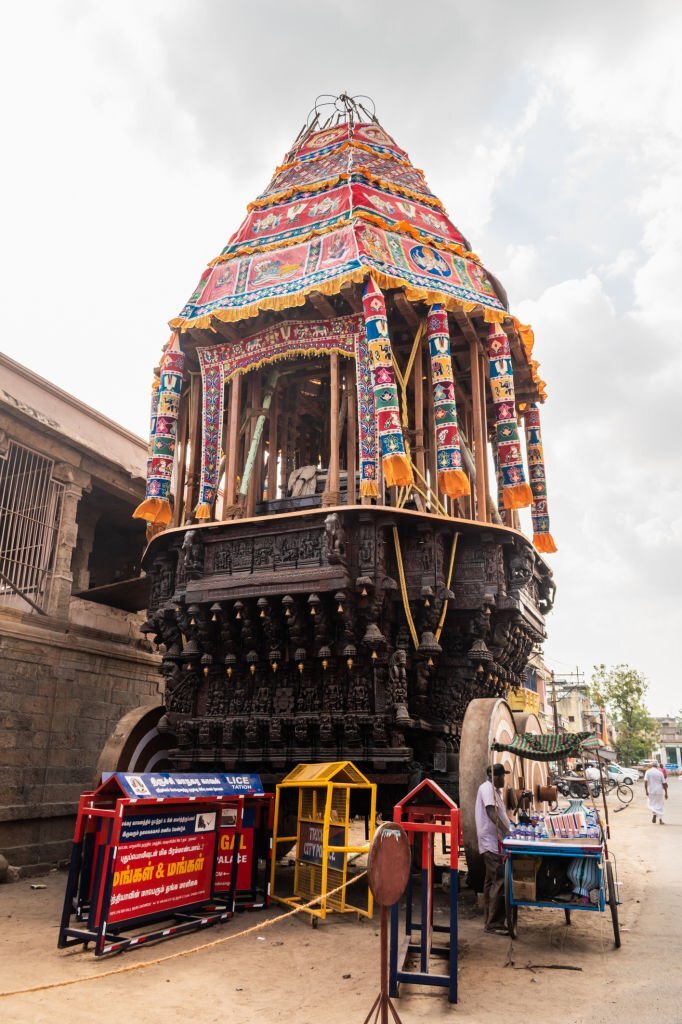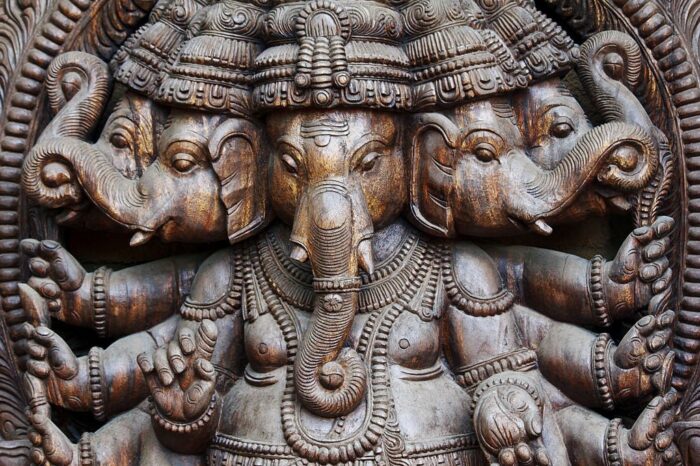The town of Arumbavur in the Veppanthattai taluk of Perambalur district, Tamilnadu, India is known for its centuries-old tradition of wooden carvings. In the past, sthapathis (master craftsmen) would travel from temple to temple creating sculptures such as chariots (rathas), statues, and other iconography in accordance with the principles of Shilpa Shastra, a Hindu treatise on the arts. Many of these original works of art are still used in temples throughout the districts of Perambalur, Ariyalur, Trichy, Salem, Villupuram, Cuddalore, Thanjavur, and Madurai.
About 250 years ago, a group of artisans settled in Arumbavur and established a thriving cottage industry creating wooden statues, functional products, miniature pieces, and replicas of carvings found in nearby temples and temple chariots. These artisans use various types of wood, including Siridam or Poo Vaagai (Indian Siris), Ma maram (mango), Mavilangam (Lingam tree), Oti (Indian Ash tree), rosewood, Vembu (neem tree), Illupai maram (Mahua), Vengai (Malabar kino), Athi (fig tree), and teak to create their sculptures.
Wooden Carvings of Arumbavur
The carvings are often inspired by the ornate sculptures and architectural motifs found in old temples. The artisans craft idols of deities such as Lord Ganesha, Goddess Saraswati, Lord Krishna, Lord Shiva, Goddess Parvathi, Lord Karthikeya, hamsa, kamadhenu, and various forms of Goddess Lakshmi, as well as decorative figures, bas-reliefs, puja mandaps and tables, chairs, and cots. These items are sold all over the world.
The artisans prefer to use local woods such as Vengai, Mavilangam, Athi, and Ma maram. First, they determine the size of the wood block needed for the desired design. The wood is then cut and naturally seasoned. A layout of the design is drawn on the cut piece with chalk, and the wood is chiseled along the lines. The rough carving is smoothed with smaller chisels and finer details are carved out. The sculpture is then polished with sandpaper and painted with natural colors or given an antique finish. Enamel paints may also be used, but are preceded by a layer of limestone. The statues are usually between 1 and 12 feet in height.
The artisans strictly follow the guidelines set forth in the Shilpa Shastra, from selecting and preparing the wood to carving and finishing the sculpture. They use traditional tools of various sizes for carving and may employ multiple craftsmen at different stages of the process based on their expertise.
The most impressive pieces produced by these skilled craftsmen are temple chariots. The base of the chariot is divided into three sections: earthly life, celestial life, and divine life. The earthly life section includes carvings of the king, queen, dancing girls, and erotica, while the celestial life section features carvings of devathas (deities), gandharvas (celestial musicians), and others. The divine life section includes carvings of Lord Shiva, Lord Ganesha, Lord Karthikeya, and the Divine Mother. The base of the chariot also features carvings of demons, with turtles above them and Adi Shesha (the serpent king) resting on top. The weight of this ornate chariot is balanced by wooden logs at the base.

The sthapathis of Arumbavur have crafted more than 400 temple chariots and 5000 temple vahanas (vehicles used to carry deities in processions) for various temples across India. In 2020, this ancient craft received a Geographical Indication Tag (GI), which is a form of intellectual property protection that recognizes the unique characteristics of a product that is connected to a specific geographical region.
In addition to creating sculptures for temples, the artisans of Arumbavur also make utilitarian products such as wooden utensils and furniture. They use the same traditional techniques and adhere to the principles of Shilpa Shastra in all of their work. The finished products are known for their high quality and attention to detail.
The craft of wood carving in Arumbavur is a testament to the skill and dedication of the artisans who practice it. Their work preserves a centuries-old tradition and continue to produce beautiful, handcrafted pieces that are treasured by people all over the world.
http://arumbavurwoodcarvings.com/
You may also be interested in Thammampatti Wood Sculptures.
